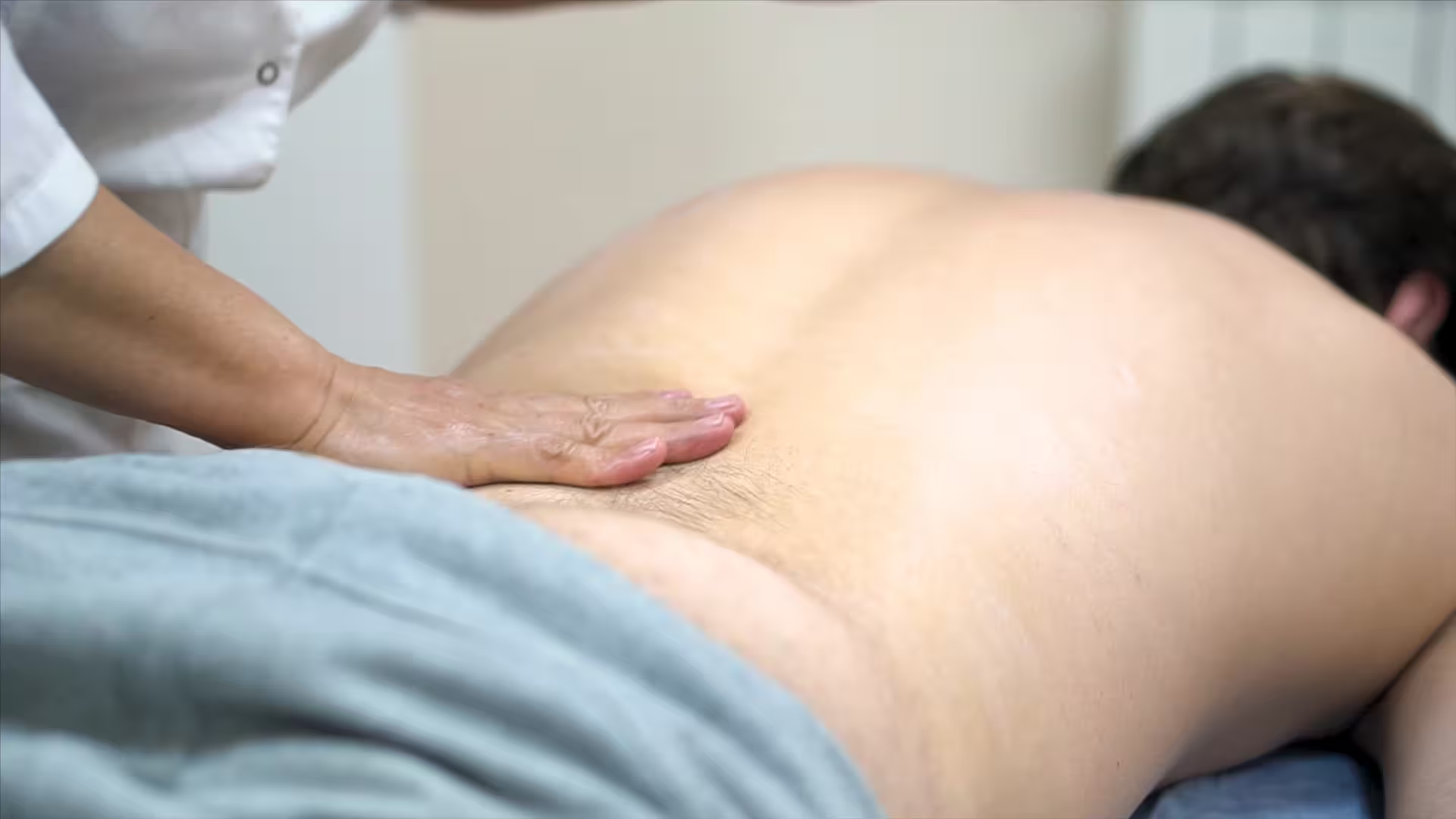Facet Joint Back Pain Treatment Southampton | Physiotherapy and Rehab

What is the best treatment for facet joint back pain?
Physiotherapy and exercise therapy are first-line treatments for facet joint back pain. Manual therapy may provide short-term relief, while injections are only recommended when pain prevents rehabilitation.
Introduction
Facet joint back pain is one of the most common yet misunderstood causes of lower back discomfort. If you have pain that feels stiff in the morning, sore after sitting too long, or aggravated when bending backwards, your facet joints may be involved.
The good news is that facet joint pain is rarely permanent or untreatable. With the right approach – combining movement, strength and tailored rehabilitation – most people return to normal activities without needing injections or surgery. At Southampton Physio, we focus on solutions that build confidence in your body and provide lasting change, not just short-term relief.

What are facet joints and why do they hurt?
Your spine is made up of a series of bones called vertebrae. Between each vertebra are small stabilising joints called facet joints. These joints act like hinges, helping guide and control movement. They are also lined with cartilage and surrounded by a capsule that contains nerves.
Facet joints can become painful for several reasons: – Stiffness or inflammation after prolonged sitting or inactivity. – Age-related changes such as arthritis, which are common but do not always cause symptoms. – Sudden overload from twisting, lifting or repetitive movements. – Postural or lifestyle factors, where long hours in one position place extra stress on the joints.
It’s important to know that changes in the facet joints are a normal part of ageing and are often seen in people with no pain at all. Pain happens when these joints become irritated or overloaded, not simply because they look different on an X-ray or MRI.
Our approach avoids fear-based language about “wear and tear”. Instead, we focus on what you can do: moving in varied ways, building strength and making adjustments to daily habits.

Symptoms and when to seek help
Facet joint pain often has a distinctive pattern. Many people describe: – Stiffness in the lower back, especially first thing in the morning or after sitting for long periods. – Pain when leaning backwards or twisting the spine. – Localised soreness near the affected joints, sometimes spreading into the buttocks or thighs. – Improvement with movement – gentle walking or stretching often eases symptoms.
Unlike disc-related pain, facet joint pain usually does not cause sharp nerve symptoms like pins and needles, weakness or significant leg pain. If you do experience those, it’s important to get assessed to rule out other causes such as sciatica.
Facet joint pain can range from mild and nagging to more intense flare-ups that limit your activities. But in most cases, with the right treatment plan, symptoms improve steadily. Early reassurance, safe movement and professional guidance are key to breaking the cycle of pain and stiffness.

How physiotherapy helps recovery
Physiotherapy is one of the most effective and well-supported treatments for facet joint back pain. Our aim is not only to reduce your current symptoms but also to prevent them from recurring.
At Southampton Physio, we take a comprehensive approach that blends hands-on care with active rehabilitation.
- Exercise therapy: Research consistently shows that exercise is the most reliable long-term solution for back pain, including facet joint problems. Your clinician will design a programme that restores spinal mobility, builds core and back strength and improves endurance. These exercises are tailored and progressed gradually.
- Manual therapy: Hands-on techniques - such as joint mobilisation or soft tissue work - can help to temporarily reduce pain and stiffness. We use these methods to make movement more comfortable but never as a standalone fix. They are always paired with active strategies to create lasting improvement.
- Education and reassurance: Understanding why pain happens is a powerful part of recovery. By removing fear and uncertainty, people often notice an immediate boost in confidence and movement.
- Integrated coaching: Our clinicians also coach fitness, meaning you’ll learn how to safely return to activities you enjoy without worrying about setbacks.

Treatment options explained
There are many possible treatments for facet joint back pain, and it’s natural to feel confused about which is best. Here’s how they compare, based on current guidelines and evidence.
- Conservative management: Includes physiotherapy, exercise, manual therapy and lifestyle changes. These are safe, cost-effective and suitable for most people.
- Injections: Facet joint injections may provide temporary relief, particularly if pain is severe and preventing progress with rehab. Benefits are usually short-lived and do not address the underlying cause.
- Surgery: Rare for facet joint pain. Considered only if conservative care and injections fail, and clear structural pathology exists.
- Medications: Simple pain relief may help during flare-ups. Long-term reliance on medication is discouraged.
- Lifestyle and holistic support: Addressing sleep, stress, pacing and general fitness makes a big difference in outcomes.

Self-care and lifestyle strategies
There are many possible treatments for facet joint back pain, and it’s natural to feel confused about which is best. Here’s how they compare, based on current guidelines and evidence.
- Movement variety: Avoid sitting or standing in one position for too long.
- Strength training: Building muscle support around your spine protects your joints.
- Sleep and recovery: Good sleep reduces pain sensitivity.
- Stress management: Stress can amplify pain. Use strategies like breathing, mindfulness or walking.
- Activity pacing: Stay active within tolerable limits to maintain mobility.

Success stories and patient journeys
Many people come to us frustrated, having tried different treatments without lasting relief. Here are two examples (shared with permission):

Frequently asked questions
How long does facet joint pain take to heal?
Many people notice improvement within a few weeks, though full recovery can take several months.
Can facet joint pain be permanent?
In most cases, no. With exercise and lifestyle strategies, outcomes are good.
Is walking good for facet joint back pain?
Yes. Gentle walking reduces stiffness and maintains mobility.
Do I need an MRI or X-ray?
Not usually. Imaging is only needed if red flag symptoms are present or conservative care fails.
What should I avoid with facet joint pain?
Avoid long periods of immobility. Focus on pacing and gradual movement.

Book your facet joint assessment in Southampton
If you’re struggling with back stiffness or pain that sounds like facet joint problems, don’t wait for it to get worse. An assessment at Southampton Physio will: – Rule out anything serious with a thorough screening. – Identify whether your facet joints are the likely source of pain. – Create a personalised plan focused on exercise, strength and lifestyle.
You’ll leave your first appointment with clear answers and a path forward – not a generic sheet of exercises.
Ready to take the next step? Book your assessment today and start building confidence in your back again.

Booking
Take the next step in your recovery
Don’t let back pain hold you back.
👉 Book your facet joint assessment today and start your recovery with Southampton’s trusted physio team.
Not ready to book yet?
That’s okay. Explore our resources, read our case studies or get in touch with a quick question – we’re here to support you at your own pace.
Disclaimer
This information is for education only and is not a substitute for personal medical advice. Consult a qualified professional for individual care.